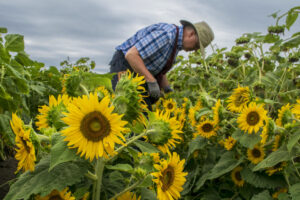Agriculture
January 9, 2024—Thomas Edison focused on more than lightbulbs. He also spent time investigating alternative supplies to natural rubber for his friend Henry Ford. This came as Ford tried to establish rubber tree plantations in South America but failed for a variety of reasons, including due to disease. Eventually, disease would almost completely wipe out rubber trees in that part of the world.
Edison attempted to use goldenrod, the yellow-flowered perennial as a rubber substitute, but was unsuccessful. Traveling in time to modern day, Edison Agrosciences believes the sunflower offers a more sustainable and climate friendly solution to rubber production.
“Sunflower leaves already have some natural rubber in them, so we’re coaxing the plant into producing a little bit more,” said Edison Agrosciences CEO David Woodburn. “Ideally, this will be a dual use of the crop where it’s still harvested for the seeds and oil, but farmers will also be rewarded for collecting the leaves at the same time.”
The reason Edison Agrosciences is hoping to cultivate natural rubber from sunflowers is that nearly all current production is in Southeast Asia, and to plant rubber trees, mass deforestation of crucial rainforests would need to occur. It is a similar situation to that of palm trees for palm oil.
“At some point the disease that wiped out rubber production in South America,” Woodburn said, “is likely going to transfer somehow to the plantations in Southeast Asia. Because of that, there’s a strong desire to develop alternatives.”
Many U.S. farmers already use sunflowers as part of their crop rotation. According to Woodburn, there are a million and a half acres of sunflowers in the U.S., with much more worldwide. Since the U.S. imports about 2 billion pounds of natural rubber every year, having a source within the country is a major advantage.

Edison Agrosciences harvests sunflowers because their leaves offer a more sustainable and climate friendly solution to rubber production. Photo from Edison
“Without any improvements, sunflower plants already being grown in the U.S. produce around 50,000 tons of rubber in their leaves each year,” Woodburn said. “I grew up on a farm and my family still owns a farm. If we’re asking the farmer to do something different, the farmer has to make some money. If the farmer receives an extra income stream for the leaves on a per-acre basis, it looks better economically. Farmers can be risk averse towards something new, but that’s if you make them pay up front. With sunflower rubber, they make a bit more money on a crop they’re already growing, and we’re creating a raw material this country uses a lot of, but cannot produce today.”
Edison Agrosciences is part of the Wells Fargo Innovation Incubator (IN2)’s 11th cohort. As part of their project, Edison Agrosciences is using a predictive breeding approach. That is what they worked on last summer with a crop grown at the Donald Danforth Plant Science Center in St. Louis, Missouri.
“IN2 allowed us to advance the program much faster than we could have with just external capital,” Woodburn said. “With the IN2 funding and Danforth Center resources, we were able to evaluate hundreds of sunflower varieties for rubber content, develop that predictive breeding model, and put it to use.”
Edison Agrosciences got a major boost before it started growing the crop at the Danforth Center. Part of the original IN2 project plan was to sequence the genes of the plants grown last summer. However, before starting, they discovered a collection of already sequenced sunflower strains at the U.S. Department of Agriculture (USDA).
“Last time we ran this trial, we ordered what we thought was the entire collection: 125 varieties,” Woodburn said. “Then we talked to the woman who runs the collections and she said: ‘125? I’ve got thousands.’”
The original plan was to study 400 varieties, but they were able to use 600. After reviewing the entire, already sequenced, collection, Edison Agrosciences chose appropriate varieties and is now working on crossbreeding them. The information from the USDA saved the company at least a year of work. Furthermore, the data gleaned from last summer’s crop will allow the company to plan a pilot program this coming summer, which will allow Woodburn to collect many more leaves with higher rubber content and extract that rubber.
“Once we have those rubber samples, then the commercial prospects open up considerably,” he said. “With sufficient quantities, we can do exploratory work and blending with other polymers for different applications. That’s our goal at the end of the pilot—to have what many potential partners want: samples and specs.”
